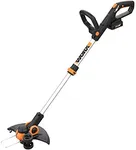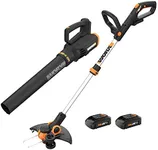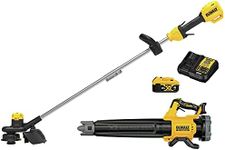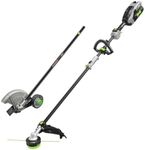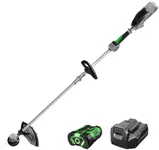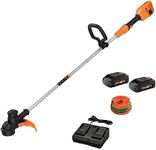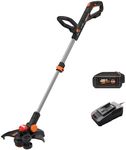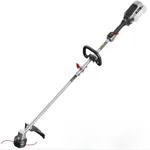Buying Guide for the Best Weed Wackers
Choosing the right weed wacker, also called a string trimmer, can make yard care much easier and more efficient. Before you buy, think about how big your yard is, what type of weeds or grass you’ll be tackling, how often you’ll use the tool, and your comfort with handling garden equipment. Knowing which features matter most will help you get a tool that fits your needs and is easy for you to use.Power SourceWeed wackers come in three main types based on their power source: gas-powered, corded electric, and battery-powered. Gas models are usually the most powerful, great for large yards and heavy weeds, but they are heavier, noisier, and require more maintenance. Corded electric trimmers are lighter and quieter, but you’re limited by the length of your extension cord and need access to an outlet. Battery-powered trimmers offer good mobility without fumes, but their power and run-time depend on battery capacity. Think about your yard size, the thickness of vegetation, and whether easy mobility or more power matters most to you.
Cutting WidthCutting width refers to how wide a path the trimmer cuts in a single pass. Wider cutting widths (around 14–18 inches) save time on larger yards and can handle thicker weeds, but may make the tool heavier and less precise in tight spaces. Narrower widths (around 10–13 inches) are lighter and easier to maneuver, perfect for small yards or for trimming around flower beds and obstacles. Pick a cutting width that matches your yard’s size and the kind of areas you’ll be trimming most often.
Line Feed SystemThe line feed system determines how the trimmer releases more cutting line. There are bump feed, automatic feed, and fixed line systems. Bump feed lets you manually release more line by tapping the head on the ground, which gives more control but needs more effort. Automatic feed advances the line as needed, making operation simpler but sometimes less reliable. Fixed line uses pre-cut lengths you have to replace by hand, good for short or infrequent jobs. Think about your comfort with making adjustments and whether you prefer more control or convenience.
Weight and ErgonomicsThe weight and design of the weed wacker affect how comfortable it is to use, especially for longer sessions. Heavier trimmers can cause fatigue but may handle thick weeds better, while lighter models are easier for all users but might be less durable or powerful. Look for features like adjustable handles, telescoping shafts, and balanced designs to make handling easier. Your physical strength and how long you’d typically use the tool should help guide what feels best for you.
Noise LevelWeed wackers can be loud, especially gas-powered models. Electric and battery options are generally quieter, making them more neighborhood- and user-friendly. If you’re sensitive to noise or have close neighbors, a quieter model may suit you better. Think about when and where you’ll be trimming to decide if noise level is a big concern.
Versatility and AttachmentsSome weed wackers can accept attachments to do more than just trim weeds—they might work as edgers, blowers, or pruners with the right add-ons. If you want a multi-use tool that can help with more yard tasks beyond trimming, check if the model you’re considering is compatible with attachments. Your landscaping needs and desire for a flexible tool should guide you here.
